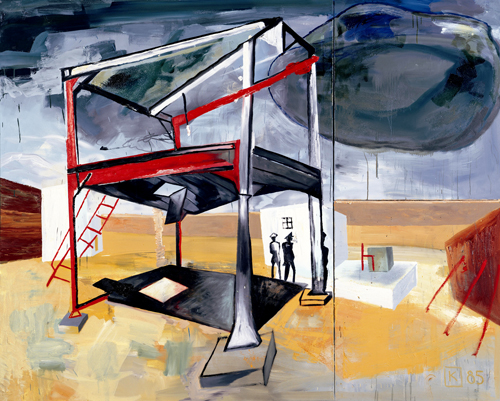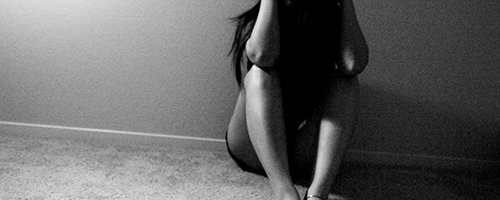You wonder what runs through the mind of an artist who draws a Fred the Frog figurine on a cross with a pitcher of beer in its hand and an egg in its armpit. This is one of the many sights to behold when you visit the Martin Kippenberger exhibition at the Portland Art Museum.
Martin Kippenberger, the German Picasso

You wonder what runs through the mind of an artist who draws a Fred the Frog figurine on a cross with a pitcher of beer in its hand and an egg in its armpit. This is one of the many sights to behold when you visit the Martin Kippenberger exhibition at the Portland Art Museum.
“It is part of an ongoing series of contemporary art exhibitions, one-man shows, which are unseen in our area,” explained Bruce Gunther, chief curator of modern and contemporary art at the Portland Art Museum. “The Martin Kippenberger exhibition is an exploration of this late German artist’s production.”
The exhibition has been on display since October and is scheduled to end Monday, Feb. 20, so it’s not too late to check it out.
Sue Taylor, an art historian at Portland State, said that Kippenberger is “a fascinating artist, the most mercurial imaginable, and this selection of paintings, sculpture and works on paper gives Portland audiences a good sense of how he made a virtue out of artistic inconsistency.”
Kippenberger’s work was seen all over Europe, according to Gunther, and it became “a voice for the new aesthetic that is ironic and freebased association.”
“You dip into history, you take personal experience, you grab at something in technology, you create a shuffle—and it’s not a clean shuffle; the cards don’t settle in one neat deck,” Gunther said. “You have to keep pushing more in, and every time [Kippenberger] would do this he would find something fresh.”
The first things you see when you enter the Martin Kippenberger exhibition are drawings that express a variety of concepts relating to politics, sexuality and culture. Gunther explained that Kippenberger spent much of his time in hotels where he received free paper, and the drawings now on display at the Portland Art Museum were the result.
“The hotel drawings evince the very peripatetic nature of his life and career,” Taylor said. “I love the romance of this series: the itinerant artist, alone in his hotel room in a strange city, recording his personal preoccupations on the stationery he takes from the desk drawer. And what does he think of? Essential things: self, sex, family, work, art.”
His drawings show a consistent vehicle for invention: momentary, emotional, sexual, comic and political.
“They incorporate all of the various ideas that he would play with later in the larger paintings,” Gunther said. “So with the 17 hotel drawings, you see [Kippenberger] inventing ideas, cartooning, drawing self-portraits, thinking about a conversation he’s had during the course of his day.”
There are three self-portraits in the Kippenberger exhibition. The one that seems to stand out the most is a painting with a sausage swastika and Kippenberger wearing white swim trunks. Gunther explained that the white swim trunks are a symbol of Picasso and the bandage on Kippenberger’s head symbolizes himself rising to a challenge.
“He’s battling history, associating himself with one of the great masters of the 20th century—and in a combative and confrontational way,” Gunther said, noting that the swastika on the painting gradually fades into the background. “He was born in 1956, and part of what that says is, ‘I am not part of that period. I am of the generation born outside of that sin, post-war, post-Holocaust, post-Nazi.’”
In a country divided until 1989, with a very troubled relationship to its recent past, Kippenberger was “part of a generation unmoored,” according to Taylor.
“When he famously got himself beaten up by a group of punks he taunted in a bar—it’s said, by making an obnoxious display of himself with Nazi blathering—he brought punishment on his own person in a symbolic enactment of national atonement,” Taylor said. “His proudly battered image appears in the untitled self-portrait in the museum’s exhibition, where he presents himself with his head bandaged, fists raised and one eye swollen shut.”
The Fred the Frog figurine is another self-portrait titled “What Is the Difference Between Jesus and Casanova When Being Nailed?”
“At one point, Kippenberger is attacked by all the European critics for his work, for all the obvious reasons, and he’s feeling persecuted so he draws this connectivity between his persecution and Christ’s persecution,” Gunther said. “He sees himself as a parallel, but he also recognizes that he’s a bit like Fred the Frog, so he’s holding a beer stein and his body is marked with sores.”
Unfortunately, Kippenberger had a tendency to drink excessively, a habit that destroyed his liver.
“He lived within that social milieu that validated continual drinking, but it killed him, literally killed him,” Gunther said. “But during the course of his nine-year career he had six to eight one-man exhibits per year. Incredibly productive. He was continuously thinking and drawing and making art in various stages of consciousness.”
“Kippenberger was a hard drinker, and sometimes skewered by critics, as the absurd frog is tortured here,” Taylor said. “[As for] the little bumps all over his body, Kippenberger has in mind the painful boils on the suffering Christ in the Isenheim Altarpiece, that great icon of German Renaissance art.”
Taylor added that Kippenberger is responding to an ambiguous situation, “where the truth is covered over with evasions, falsehoods and forgetting.”
“Don’t we see this in our own American politics every day? In these circumstances, the artist assumes an antagonist stance, yet still can’t escape feelings of complicity,” Taylor said. “That’s why he boasts in the contradictory title of another painting in the exhibition, “‘My Lies are Honest.’”
Martin Kippenberger
On view through Monday, Feb. 20
Tickets: adults $15; seniors $12 Free for members and children 17 and under



